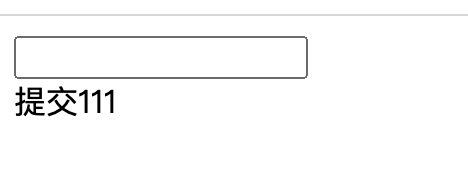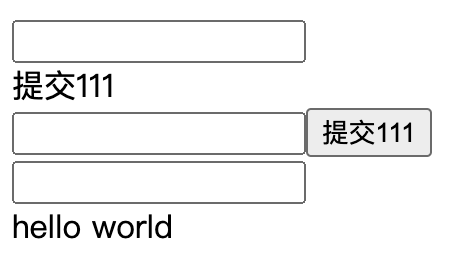Vue3之插槽(Slot)

何为插槽
我们都知道在父子组件间可以通过v-bind,v-model搭配props 的方式传递值,但是我们传递的值都是以一些数字,字符串为主,但是假如我们要传递一个div或者其他的dom元素甚至是组件,那v-bind和v-model搭配props的方式就行不通了,但是插槽(slot)可以,插槽可以传递dom元素,在子组件中通过接收使用父组件传递过来的dom元素,我的理解就是在定义一个组件时,有些dom是动态显示的,即子组件现在不清楚调用它的组件需要咋显示,是显示button还是div,所以使用slot先占一个位置,父组件确定要显示的dom后再显示。
示例解析
插槽的基本使用
假设我们要实现一个form表单组件,由一个输入框和一个按钮组成,如下图

这时候按钮的样式可能是多样的,有的人喜欢使用button,有的喜欢使用div,所以这里我们可以将显示按钮的这里定义成一个插槽,子组件的定义如下:
app.component('my-form',{methods:{handleClick(){alert(123);}},template:` <div><input /><span @click="handleClick"> <slot></slot> //定义插槽</span></div>`});
注意: slot 插槽上面是无法绑定事件的,可以在上面使用一个<span>标签专门绑定事件
使用插槽:我们在使用插槽的时候可以传递一个div
<my-form><div>{{text}}</div> </my-from>
可以传递一个button
<my-form><button>{{text}}</button>
</my-from>
还可以传递一个组件
定义一个test组件
app.component('test',{template:`<div>hello world</div>`})
传递组件给子组件
<my-form><test />
</my-from>
所有测试代码:
<!DOCTYPE html>
<html lang="en">
<head><meta charset="UTF-8"><meta http-equiv="X-UA-Compatible" content="IE=edge"><meta name="viewport" content="width=device-width, initial-scale=1.0"><title>Vue使用插槽</title><script src="https://unpkg.com/vue@next"></script>
</head>
<body><div id="root"></div>
</body>
<script>const app = Vue.createApp({data() {return {text:"提交111"}},template: `<my-form><div>{{text}}</div> </my-from><my-form><button>{{text}}</button> </my-from><my-form><test /> </my-from>`});app.component('test',{template:`<div>hello world</div>`})app.component('my-form',{methods:{handleClick(){alert(123);}},template:` <div><input /><span @click="handleClick"><slot>default</slot></span></div>`});const vm = app.mount('#root');
</script>
</html>
注意:我们在定义子组件的插槽时: <slot>default</slot> 会在slot中间写一个defult这里其实是为了做一个默认值处理,也就是父组件什么也不传的时候,我们就显示默认的值不加这个默认值,页面显示会有问题
运行结果:

具名插槽
我们的一个web页面结构分为:header,content,footer,我们要把header,footer做成一个插槽,让其显示:
 按照我们第一小节的做法:
按照我们第一小节的做法:
定义一个组件:
app.component('layout',{template:`<div><slot></slot><div>content</div></div>`});
使用:
template: `<layout><div >header</div><div >footer</div></layout>`
运行后我们发现不太对:

content无法放到header和footer之间,所以我们需要使用具名插槽,给插槽一个具体的名字,好摆放其位置:
把布局组件定义为:
app.component('layout',{template:`<div><slot name = "header"></slot><div>content</div><slot name = "footer"></slot></div>`
});
使用插槽时:
const app = Vue.createApp({// 具名插槽template: `<layout><template v-slot:header><div >header</div></template><template v-slot:footer><div >footer</div></template></layout>`});
提示:具名插槽可以使用#header方式代替v-slot:header
所有测试代码:
<!DOCTYPE html>
<html lang="en">
<head><meta charset="UTF-8"><meta http-equiv="X-UA-Compatible" content="IE=edge"><meta name="viewport" content="width=device-width, initial-scale=1.0"><title>使用具名插槽</title><script src="https://unpkg.com/vue@next"></script>
</head>
<body><div id="root"></div>
</body>
<script>const app = Vue.createApp({// 具名插槽template: `<layout><template v-slot:header><div >header</div></template><template v-slot:footer><div >footer</div></template></layout>`});app.component('layout',{template:`<div><slot name = "header"></slot><div>content</div><slot name = "footer"></slot></div>`});const vm = app.mount('#root');
</script>
</html>
运行结果:
 这样content就被准确的放到了中间啦。
这样content就被准确的放到了中间啦。
作用域插槽
当我们在使用插槽时,父组件想使用子组件的值,我们就可以使用作用域插槽。
假设定义了一个list组件,在子组件中提供了一组list值,父组件想使用这个list的值。定义组件的代码如下:
app.component('list',{data(){return{list:[1,2,3]}},template:`<div><slot v-for="item in list" :item="item" /></div>`});
使用时如下:
const app = Vue.createApp({// 解构语法template: `<list v-slot="slotProps"><span>{{slotProps.item}}</span></list>`});
这里使用的时候可以使用解构语法,写成:
// 解构语法
template: `<list v-slot="{item}"><div>{{item}}</div></list>`
这里需要注意v-slot="{item}里面的item必须和<slot v-for="item in list" :item="item" />这里对应,不然无法渲染出来
总结
本文主要是介绍了组件间作用域的插槽使用,插槽的使用能使我们页面的模块化更灵活,使用起来更方便,读者可以领会后多做练习,争取在项目中能很好的使用插槽知识,让我们的项目代码的复用性,可维护性更好。


